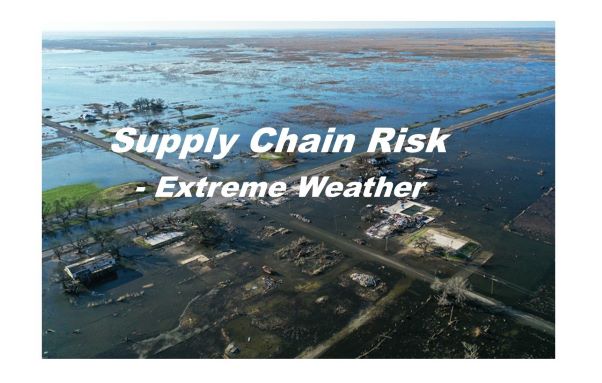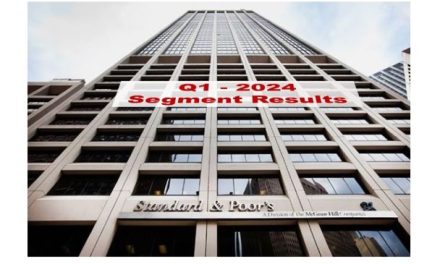Heatwaves and fires have been wreaking havoc across Europe in recent weeks, as well as flooding which has caused immense damage in China, the US and Slovenia, among other countries.
 All the evidence indicates that the scale of global hazardous weather events is ever increasing.
All the evidence indicates that the scale of global hazardous weather events is ever increasing.
Figures from Resilinc, a global supply chain mapping, monitoring and resiliency analytics company, further highlight the urgency of this situation.
Data gathered by our 24/7 global event monitoring platform, EventWatchAI, has revealed a 289% increase in the number of potential disruptions and alerts related to extreme weather worldwide between 2019 and 2023.
Flooding disruption alerts soared by 685% world over for the same period.
Our data ranked extreme weather the 11th highest reported global supply chain disruption last year and there’s no denying this impact.
For example, the Panama Canal, a vital link between the Pacific and Atlantic basins, has recently extended restrictions on the maximum depth for ships and limited the average transit of vessels per day due to the ongoing drought and low water levels. Consequently, such measures ripple through supply chains, causing delays, limiting production, and driving up costs and prices.
As increasingly frequent and severe weather events pose a serious threat to companies, they must take proactive action to protect and secure their supply chains. And while pinpointing the exact time and location of such extreme weather events remains impossible, there are proven strategies that businesses can adopt to prepare for and mitigate weather’s impact on the supply chain.
- Comprehensive supply chain mapping
The foundation begins with mapping your entire supply chain down multiple tiers. By doing so, you can gain complete visibility into the origins of all your parts and raw materials, which will enable you to identify potential risks in your supply chain. Through mapping, you can strategically relocate high-risk products away from threatened areas, locate alternative sites, and redirect operations well before the extreme weather event unfolds.
- Conduct regular risk assessments and data analysis
Now the supply chain is mapped, how prepared are your suppliers for extreme weather? Conduct regular supplier risk assessments by sending out ongoing risk evaluations to suppliers. By evaluating their preparedness across all sites, you can identify those requiring improvements and work with them to close the gaps.
Another key element in identifying weak links in the supply chain is data analysis. Through historical and validated data, you can quickly ascertain whether some locations are more prone to weather-related disruption than others. With this data at their fingertips, organisations can make informed decisions quickly.
Notably, Resilinc’s recent study found that only 11% of supply chain sites are fully prepared for disruptive weather events due to climate change. The study, which included supply chains of 100 original equipment manufacturers in the high-tech, automotive, and consumer goods industries, spanning Tier 1 and Tier 2 suppliers across 12,000 manufacturing facilities in the US, China and Taiwan, also revealed that half of the sites are at high risk of being hit by storms, flooding, heatwaves, droughts and fires.
- Harness AI-powered monitoring tools
The next step should be ensuring you have real-time insights into any potential supply chain threats. Invest in AI-powered monitoring tools with predictive analytics capabilities that will allow you to prepare for severe weather before it strikes and/or react immediately to disruptions moments after they occur. In a crisis situation, time is of the essence – the use of artificial intelligence and machine learning can eventually lead to a level of automation where decisions are made in a split second.
- Have a backup plan in place
Finally, the basis of any effective weatherproofing strategy should be a backup plan. Employers and employees need to have a prepared playbook everyone is familiar with so when a disruption occurs, operations won’t be discontinued. Adopting a proactive approach decision-makers can act quickly, make informed decisions, and, ultimately, emerge from the disruption uninterrupted.
Given the growing concern over climate change and its impact, investing in technology-based supply chain risk management tools is becoming essential to organisations to mitigate the risks of severe weather and stay ahead of inevitable disruptions.
When navigating the impacts of extreme weather events, companies need a multi-level approach that includes enhanced supply chain visibility, strong supplier relationships, and advanced monitoring and planning tools. Only then can businesses better assess potential impacts and respond swiftly to minimise potential losses.
Posted by Bindiya Vakil in Risk – Bindiya Vakil is the CEO and co-founder of Resilinc.
 Source: Cips.org
Source: Cips.org


























